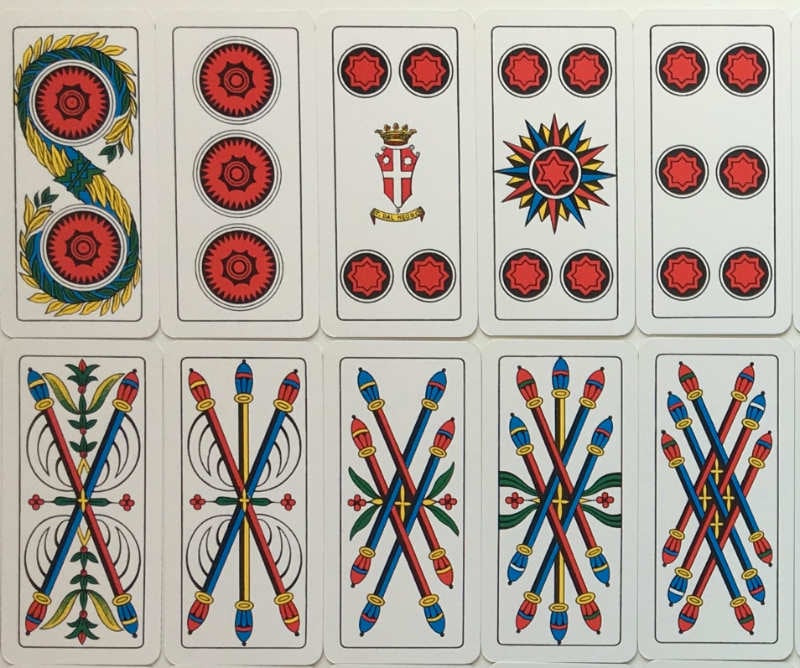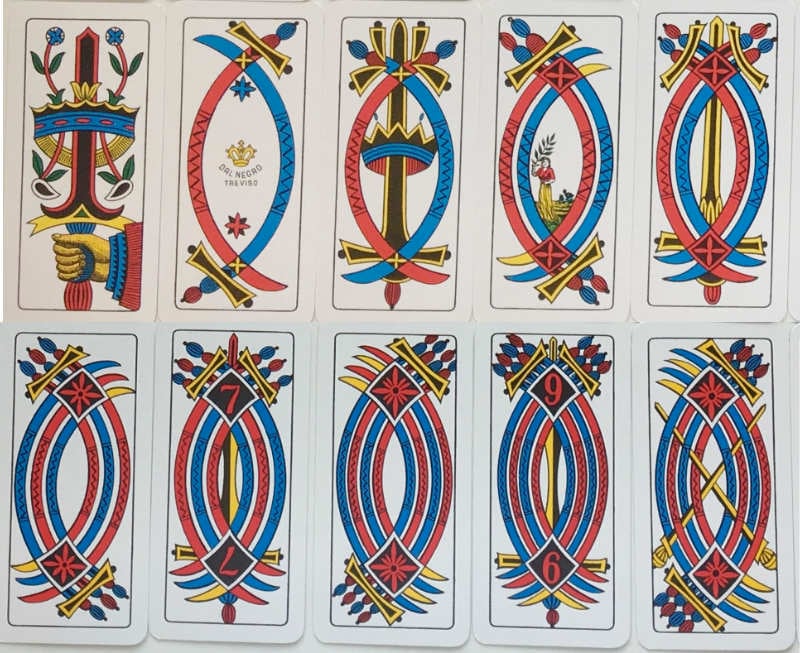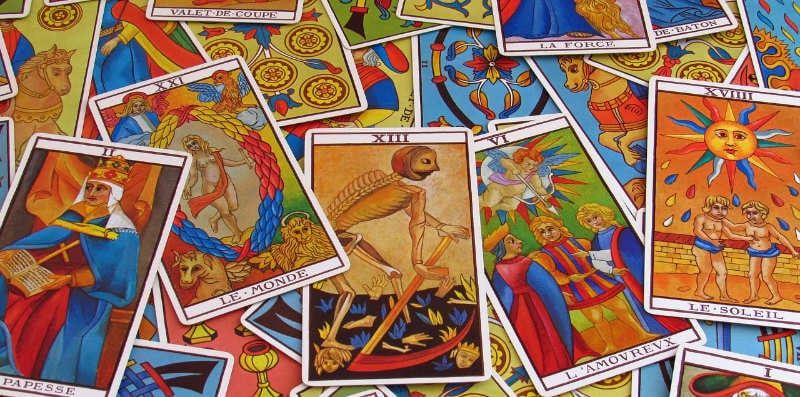What is the Tarot de Marseilles?
Popular in France during the 18th and 19th century, the iconic Tarot de Marseille was an early version of the modern tarot decks we know and love today. Named after the southern French city of Marseilles, the deck is also known as the Tarot of Marseilles, the Marseilles Tarot and the Marseille Tarot (without the final ‘s’).
Many of the features and artwork found today’s modern tarot decks, borrow heavily from the Tarot de Marseille’s beautiful illustrations and timeless design traditions.
modern decks feature a fully illustrated Minor Arcana, while Marseilles decks feature numbered “pip cards” similar to playing cards
If you’re used to modern tarot decks, the biggest difference between modern tarot cards and the Tarot de Marseilles is that modern ones feature a fully illustrated Minor Arcana. Marseilles decks on the other hand, feature numbered “pip cards” which are similar to playing cards. A common complaint of new readers is that the lack of an illustrated Minor Arcana can make the Tarot de Marseilles less intuitive and difficult to learn.
Before diving in, let’s clear up two common points of confusion about the Tarot de Marseilles:
- There is no single Tarot de Marseille deck. The name applies to a period and style of tarot cards, all of which share similar design traits and deck size.
- While the Tarot de Marseille was used principally for playing card games like tarocchi, and not for cartomancy, the deck’s popularity for use in tarot readings rose sharply in the late 19th century. As the deck’s popularity with tarot readers grew, some latter-day “Marseilles decks” were created which contain visual cues to assist with divination. While they can be excellent decks, these modern versions are not generally considered “true” Marseilles decks. A true Marseilles deck stays true to the historic tradition and time period.
How many cards are in the Marseille Tarot?
As with most modern decks of tarot cards, the Tarot de Marseille contains 78 cards. There are 56 suit-cards or Minors and 22 illustrated “Atouts”, or Majors.
As with modern decks of tarot cards, the 56 suit-cards (the Minor Arcana) are divided into four tarot suits.
NOTE: While the names “Minor Arcana” and “Major Arcana” were not used historically to describe the parts of the Marseille deck, tarot readers today often retroactively apply these occult tarot terms to the Tarot de Marseille. To be historically accurate we will refer to them simply as “Major cards” and “Minor cards” here, rather than the Major Arcana or Minor Arcana.
The Tarot de Marseille vs. Rider Waite
When comparing the Tarot de Marseille with modern tarot decks like Rider-Waite, the most noticeable difference is the lack of meaningful illustrations on the numbered suit cards. The cards from Ace to 10, have much more in common visually with contemporary playing cards than with we think of as tarot cards today.
Here’s an example of some Minor cards from the Tarot de Marseille:

Sample of the Tarot de Marseille suit of Coins and Suit of Wands
Unlike the deck above, the Rider-Waite deck, illustrated by Pamela Colman-Smith, was the first tarot deck to feature illustrations instead of the numbered “pip cards” shown above. The lack of illustrations on the lower Marseilles cards is likely the biggest reason that the Marseilles deck doesn’t enjoy more popularity today.
Tarot readers generally feel Colman-Smith’s style of fully illustrated cards make tarot interpretations easier
Many Tarot readers feel Colman-Smith’s style of fully illustrated Minor cards make tarot interpretations easier. Remembering the tarot meanings of the Marseille cards on the other hand, is a difficult chore of rote memorization.
Another difference between the Marseilles deck and contemporary decks like Rider-Waite is the names of the court cards are different.
The court cards in the Marseilles Tarot deck are as follows:
- Valet: Similar to a knave or a page.
- Chevalier: Similar to a Knight (Also called a Cavalier on some decks)
- Dame: Similar to a Queen
- Roi: Similar to a King
Like the Rider Waite tarot, the The Marseilles Tarot uses four suits. While the names of the suits are essentially the same, the French term “baton” is often used in place of “wand” even in English versions.
The Tarot de Marseilles Suits
The Tarot de Marseilles is divided into the following suits:
- Swords
- Batons (Wands)
- Cups
- Coins
What often make these suits confusing to those accustomed to modern decks, is how the suits are illustrated.
If it wasn’t already hard enough to use a deck without meaningful illustrations, the “pips” on Tarot de Marseille cards are often stacked on top of each other, forming beautiful and complex patterns. These patterns can be difficult to read for beginners.
Swords are typically drawn stylistically as curved lines. While Batons, are drawn as straight ones. Odd numbered cards typically have a vertical sword running down the middle.

The Suit of Swords Ace through 10. Only the 7 and 9 cards are shown with clarifying numerals.
The Tarot de Marseilles “Major Arcana”
The 22 trump cards of the Tarot de Marseilles are very similar to modern tarot cards. Each of the 22 cards in the Major Arcana of today’s tarot cards has a direct lineage going back to the Marseille decks.
Most of the Major cards in Marseilles decks are one direct French translation away from our modern cards, but there are some notable exceptions:
- The High Priestess tarot card is called the “Papesse“, or female-pope, in Marseilles tarot decks.
- The Hierophant tarot card in Rider-Waite is called the “Pope” in Marseilles tarot decks.
- The Tower tarot card is sometimes called “The House of God” in Marseilles decks.
- The Death tarot card is frequently unnamed in many Marseilles decks — Most likely due to a superstition that to speak (or write) the name of Death was to invite his presence.
- The Hermit tarot card is sometimes called “The Hunchback” in Marseilles tarot decks.
For the most part however, the Major cards of the Tarot de Marseilles are easily understandable to anyone with a knowledge of tarot.
Tarot de Marseilles Spreads
As with all other tarot readings, the Tarot de Marseilles can be read using single card or yes or no tarot readings, or more complicated tarot spreads.
While there’s no strict definition over what constitutes a “Tarot de Marseilles tarot spread”, spreads using the Marseilles deck tend to be smaller and simpler. (3 and 4 card Marseilles spreads tend to be the most common).
If you want to use any contemporary tarot spread using a Tarot de Marseilles deck, there’s no reason why you can’t.
There is however a big difference in how you shuffle the Tarot de Marseilles, and how you draw the cards.
Here’s how that works:
How to read the Tarot de Marseilles
While there are many different traditions for how to read the Tarot de Marseilles, the most common method is to first divide the deck into the Majors and the Minors beforehand.
Tarot spreads using Tarot de Marseilles cards are typically completed using only the Major cards.
Tarot spreads using Tarot de Marseilles cards are typically completed using only the Major cards. So after dividing the deck into Majors and Minors, you’ll shuffle both halves individually. The drawing is completed using only the Majors half.
When the Marseilles tarot reading begins however, Minor cards can be added (at the decision of the reader) to the reading by drawing a Minor card next to a corresponding Major card, in much the same way that clarifying cards are used in a conventional tarot spread.
So for example if you don’t know exactly why you’ve just drawn the “The World” card (or Le Monde, in French), you can draw an additional Minor card, and place it next to the World card for some additional insight.
In this way, each Major card in a Tarot de Marseilles spread can have an optional “clarifier” or layer of additional meaning from a paired Minor card.
Is the Tarot de Marseilles Good for Tarot Readings?
The Tarot de Marseilles is an interesting area to explore for tarot readers.
For most readers, Marseille decks are particularly challenging because the Minor cards aren’t illustrated in a style similar to Rider-Waite and other modern decks.
However, if you’re a fan of tarot cards and you enjoy historic decks, learning to read decks from the 18th and 19th century can be a fascinating adventure.



